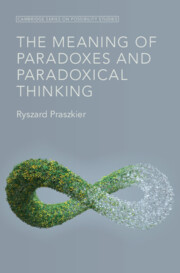Book contents
- The Meaning of Paradoxes and Paradoxical Thinking
- Cambridge series on possibility studies
- The Meaning of Paradoxes and Paradoxical Thinking
- Copyright page
- Contents
- Figures
- Tables
- Acknowledgments
- Introduction
- Part 1 Paradoxes and What They Do to Us
- Part II Sudden Unexpected Changes
- Part III Challenging the Impossible
- Part IV Peace and Its Challenges
- Part V Paradoxes and Creativity
- Introduction
- Chapter 12 Generating New and Useful Ideas
- Chapter 13 Brain Plasticity
- Chapter 14 Avenues for Enhancing Neuroplasticity
- Discussion and Summary
- Part VI Paradoxes in Action
- References
- Index
Discussion and Summary
from Part V - Paradoxes and Creativity
Published online by Cambridge University Press: 04 April 2025
- The Meaning of Paradoxes and Paradoxical Thinking
- Cambridge series on possibility studies
- The Meaning of Paradoxes and Paradoxical Thinking
- Copyright page
- Contents
- Figures
- Tables
- Acknowledgments
- Introduction
- Part 1 Paradoxes and What They Do to Us
- Part II Sudden Unexpected Changes
- Part III Challenging the Impossible
- Part IV Peace and Its Challenges
- Part V Paradoxes and Creativity
- Introduction
- Chapter 12 Generating New and Useful Ideas
- Chapter 13 Brain Plasticity
- Chapter 14 Avenues for Enhancing Neuroplasticity
- Discussion and Summary
- Part VI Paradoxes in Action
- References
- Index
Summary
Paradoxical thinking requires a higher level of creativity and divergent thinking, as analyzed in this part. Divergent thinking operates like paradoxical thinking – that is, merging unexpectedly completely unrelated ideas into one functional concept. This “thinking paradox” requires specific brain properties – namely, flexibility and malleability – called “neuroplasticity.” In this process, synapses are generated and dissolved in a continuous process that occurs during wakefulness and consciousness (Askenasy & Lehmann, 2013).
- Type
- Chapter
- Information
- The Meaning of Paradoxes and Paradoxical Thinking , pp. 113 - 114Publisher: Cambridge University PressPrint publication year: 2025

